Effect of Welding Sequence in Angular Distortion on Butt Joint GMAW Process
Abstract
1. Introduction
2. Influence of Welding Parameters on Distortions and Residual Stress Levels
3. Materials and Methods
3.1. Welding Materials
3.1.1. Base Metal and Filler Metal
3.1.2. Shielding Gas
3.1.3. Computerized Metrological Equipment
3.2. Experimental Procedures
3.2.1. Surface Preparation
3.2.2. Butt-Joint Welding Process
- SM: Symmetrical method.
- BM: Backward method.
- SP: Single-pass method with one step.
4. Results and Discussion
5. Conclusions
Author Contributions
Funding
Institutional Review Board Statement
Informed Consent Statement
Data Availability Statement
Conflicts of Interest
References
- Izeda, E.; Pascoal, A.; Simonato, G.; Mineiro, N.; Gonçalves, J.; Ribeiro, J. Optimization of Robotized Welding in Aluminum Alloys with Pulsed Transfer Mode Using the Taguchi Method. Proceedings 2018, 2, 5294. [Google Scholar] [CrossRef]
- Ahmed, Z.I.; Saadoon, A.M. Optimization Process Parameters of Submerged Arc Welding Using Taguchi Method. Int. J. Eng. Adv. Technol. 2015, 5, 149–152. [Google Scholar]
- Daniyan, I.; Tlhabadira, I.; Adeodu, A.; Phokobye, S.; Mpofu, K. Process design and modelling for milling operation of titanium alloy (Ti6Al4V) Using the Taguchi method. Procedia CIRP 2020, 91, 348–355. [Google Scholar] [CrossRef]
- Ribeiro, J.; Gonçalves, J.; Mineiro, N. Welding Process Automation of Aluminum Alloys for the Transport Industry: An Industrial Robotics Approach. In CONTROLO 2020; Springer: Cham, Switzerland, 2021; pp. 72–81. [Google Scholar]
- Pandit, M.; Sood, S.; Mishra, P.; Khanna, P. Mathematical analysis of the effect of process parameters on angular distortion of MIG welded stainless steel 202 plates by using the technique of response surface Methodology. Mater. Today Proc. 2021, 41, 1045–1054. [Google Scholar] [CrossRef]
- Sehrawat, A. Mathematical Modelling for Prediction of Angular Distortion in MIG Welding of Stainless Steel 301. Int. J. Res. Appl. Sci. Eng. Technol. 2020, 8, 884–890. [Google Scholar] [CrossRef]
- Mochizuki, M.; Okano, S. Effect of welding process conditions on angular distortion induced by bead-on-plate welding. ISIJ Int. 2018, 58, 153–158. [Google Scholar] [CrossRef]
- Deng, D.; Murakawa, H. Prediction of welding distortion and residual stress in a thin plate butt-welded joint. Comput. Mater. Sci. 2008, 43, 353–365. [Google Scholar] [CrossRef]
- Deo, M.V. Minimization of bowing distortion in welded stiffeners using differential heating. In Minimization of Welding Distortion and Buckling; Woodhead Publishing: Cambridge, UK, 2011; pp. 169–185. [Google Scholar] [CrossRef]
- Sun, Y.L.; Hamelin, C.J.; Vasileiou, A.N.; Xiong, Q.; Flint, T.F.; Obasi, G.; Francis, J.A.; Smith, M.C. Effects of dilution on the hardness and residual stresses in multipass steel weldments. Int. J. Press. Vessel. Pip. 2020, 187, 104154. [Google Scholar] [CrossRef]
- Soni, S.; Aggarwal, N. Optimization of Distortion in Welding. Int. J. Enhanc. Res. Sci. Technol. Eng. 2015, 4, 128–133. [Google Scholar]
- Mounika, S.; Rao, D.V.N.J.J. Effect of Weld Pass Sequencing On Temperature Distribution and Residual Stresses in Gmaw. J. Therm. Energy Syst. 2019, 4, 23–40. [Google Scholar]
- Podder, D.; Gupta, O.; Das, S.; Mandal, N.R. Experimental and numerical investigation of effect of welding sequence on distortion of stiffened panels. Weld. World 2019, 63, 1275–1289. [Google Scholar] [CrossRef]
- Gannon, L.; Liu, Y.; Pegg, N.; Smith, M. Effect of welding sequence on residual stress and distortion in flat-bar stiffened plates. Mar. Struct. 2010, 23, 385–404. [Google Scholar] [CrossRef]
- Radaj, D. Welding Residual Stresses and Distortion Calculation and Measurement; DVS-Verlag: Düsseldorf, Germany, 2003. [Google Scholar]
- Schenk, T. Modelling of Welding Distortion The Influence of Clamping and Sequencing. Ph.D. Thesis, TU Delft, Delft, The Netherlands, December 2011. [Google Scholar]
- Richter-Trummer, V.; Moreira, M.G.; Ribeiro, J.; de Castro, M.S.T. The Contour Method for Residual Stress Determination Applied to an AA6082-T6 Friction Stir Butt Weld. Residual Stress VIII 2011, 681, 177–181. [Google Scholar] [CrossRef]
- Costa, S.M.; Souza, M.S.; César, M.B.; Gonçalves, J.; Ribeiro, J. Experimental and numerical study to minimize the residual stresses in welding of 6082-T6 aluminum alloy. AIMS Mater. Sci. 2021, 8, 271–282. [Google Scholar] [CrossRef]
- Marques, E.; Pereira, A.; Ribeiro, J. Thermal evaluation of MAG/TIG welding using numerical extension tool. Int. J. Appl. Sci. Eng. 2021, 18, 2021006. [Google Scholar] [CrossRef]
- Nobrega, G.; Souza, M.S.; Martín, M.R.; Rodríguez-Gonzálvez, P.; Ribeiro, J. Parametric Optimization of the GMAW Welding Process in Thin Thickness of Austenitic Stainless Steel by Taguchi Method. Appl. Sci. 2021, 11, 8742. [Google Scholar] [CrossRef]
- Zain-ul-abdein, M.; Nélias, D.; Jullien, J.F.; Deloison, D. Experimental investigation and finite element simulation of laser beam welding induced residual stresses and distortions in thin sheets of AA 6056-T4. Mater. Sci. Eng. A 2010, 527, 3025–3039. [Google Scholar] [CrossRef]
- Garcia, L.M.; Noronha, V.T.; Ribeiro, J. Effect of Welding Orientation in Angular Distortion in Multipass GMAW. J. Manuf. Mater. Process. 2021, 5, 63. [Google Scholar] [CrossRef]
- Irfan, Y.A.; Memduh, K.; Ezgi, D. Angular Distortion in Butt Arc Welding. Int. J. Eng. Sci. Appl. 2018, 2, 137–144. [Google Scholar]
- Zhang, L. Modelling welding stress and distortion in large structures. In Minimization of Welding Distortion and Buckling; Woodhead Publishing: Cambridge, UK, 2011; pp. 99–126. [Google Scholar] [CrossRef]
- Adamczuk, C.; Machado, I.G.; Mazzaferro, J.A.E. Methodology for predicting the angular distortion in multi-pass butt-joint welding. J. Mater. Process. Technol. 2017, 240, 305–313. [Google Scholar] [CrossRef]
- Murugan, B.V.V.; Gunaraj, V. Effects of Process Parameters on Angular Distortion of Gas Metal Arc Welded Structural Steel Plates Mathematical models were developed to study the effects of process variables on the angular distortion of multipass GMA welded structural steel plates. Weld. J. 2005, 84, 165–171. [Google Scholar]
- Vyas, S.M.; Shah, S.I.; Acharya, G.D. Minimization of Distortion During Gas Metal Arc Welding Process: A Review. J. Exp. Appl. Mech. 2017, 8, 48–53. [Google Scholar]
- Narwadkar, A.; Bhosle, S. Optimization of MIG Welding Parameters to Control the Angular Distortion in Fe410WA Steel. Mater. Manuf. Process. 2016, 31, 2158–2164. [Google Scholar] [CrossRef]
- Ramani, S.; Velmurugan, V. Effect of process parameters on angular distortion of mig welded Ai6061 plates. In Proceedings of the All India Manufacturing Technology, Design and Research Conference, no. Aimtdr, Guwahati, India, 12–14 December 2014; Volume 2, pp. 1–6. [Google Scholar]
- Deng, D.; Murakawa, H. FEM prediction of buckling distortion induced by welding in thin plate panel structures. Comput. Mater. Sci. 2008, 43, 591–607. [Google Scholar] [CrossRef]
- Sakri, A.; Guidara, M.; Elhalouani, F. Numerical simulation of MIG type arc welding induced residual stresses and distortions in thin sheets of S235 steel. IOConf. Ser. Mater. Sci. Eng. 2010, 13, 012020. [Google Scholar] [CrossRef]
- Long, H.; Gery, D.; Carlier, A.; Maropoulos, G. Prediction of welding distortion in butt joint of thin plates. Mater. Des. 2009, 10, 4126–4135. [Google Scholar] [CrossRef]
- Kumar, P.; Jafri, S.A.H.; Bharti, P.K.; Siddiqui, M.A. Study of Hazards Related to Cutting Fluids and Their Remedies. Int. J. Eng. Res. Technol. 2014, 3, 1225–1229. [Google Scholar]
- Kumar, A. Effect of Various Parameters on Angular Distortion in Welding. Int. J. Curr. Eng. Technol. 2011, 35, 132–136. [Google Scholar]
- Ribeiro, J.E. Project based learning applied to manufacturing processes course unit. In Proceedings of the EDULEARN18, Palma, Spain, 2–4 July 2018; pp. 6881–6887. [Google Scholar] [CrossRef]
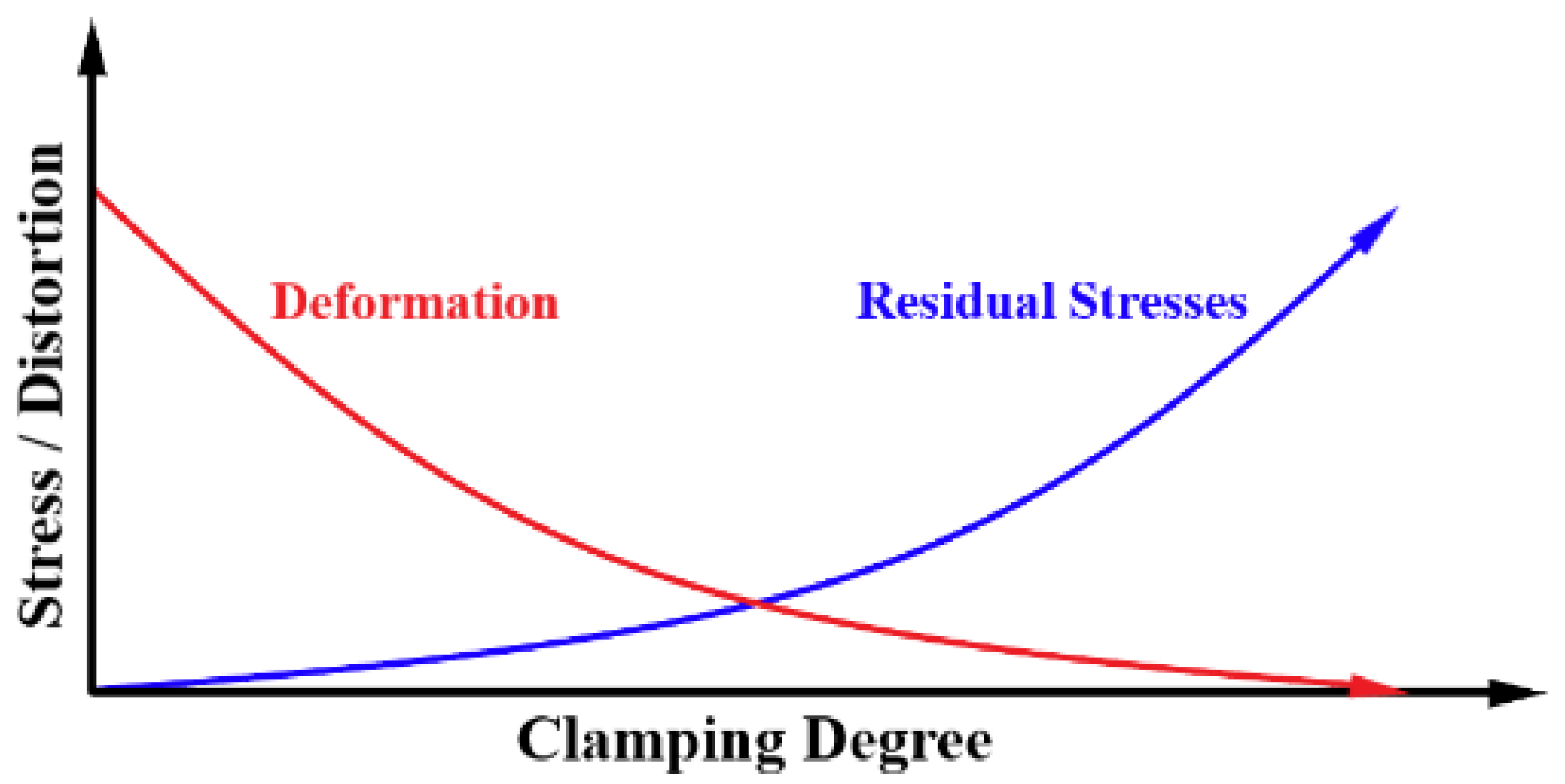

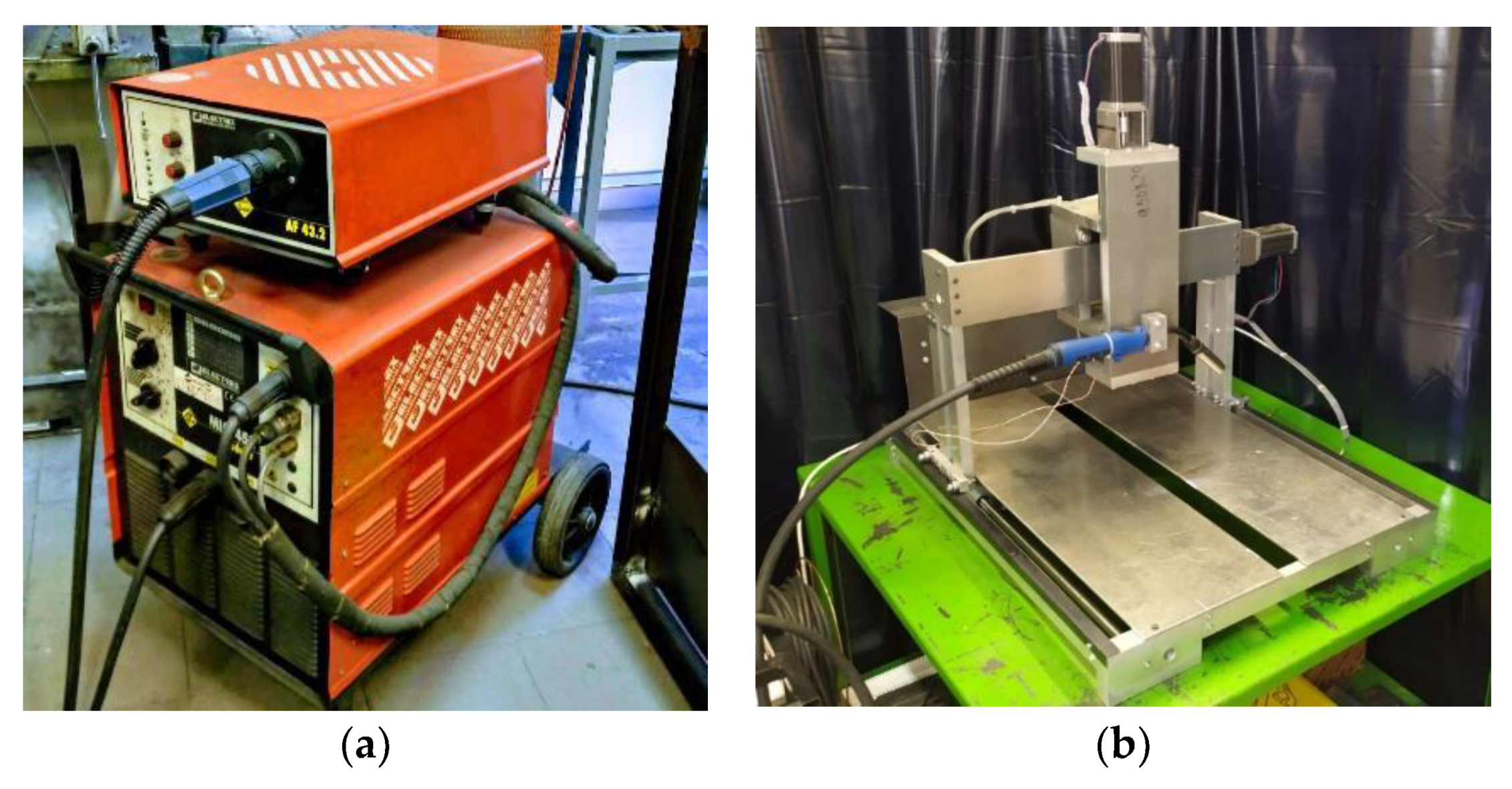
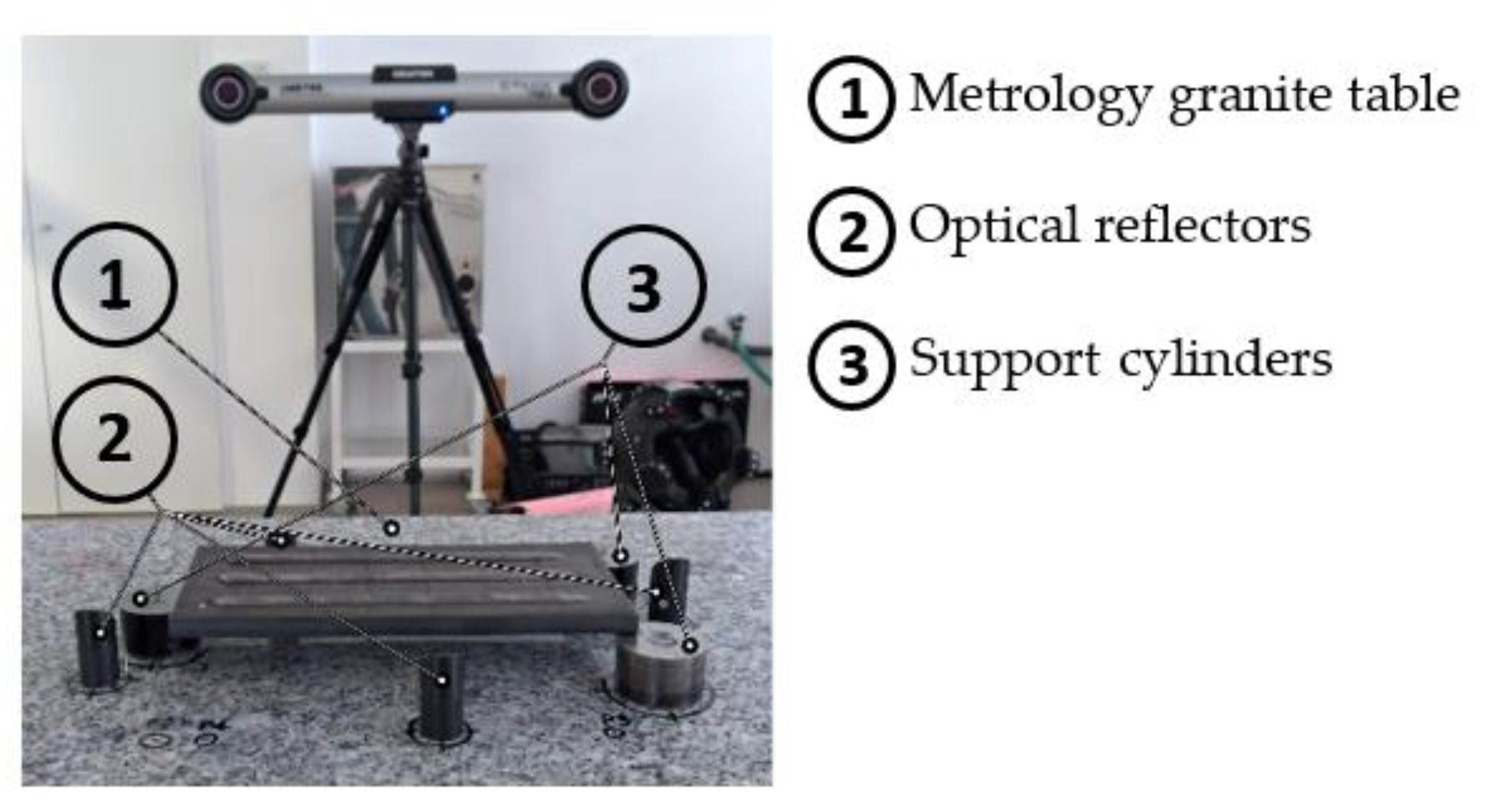
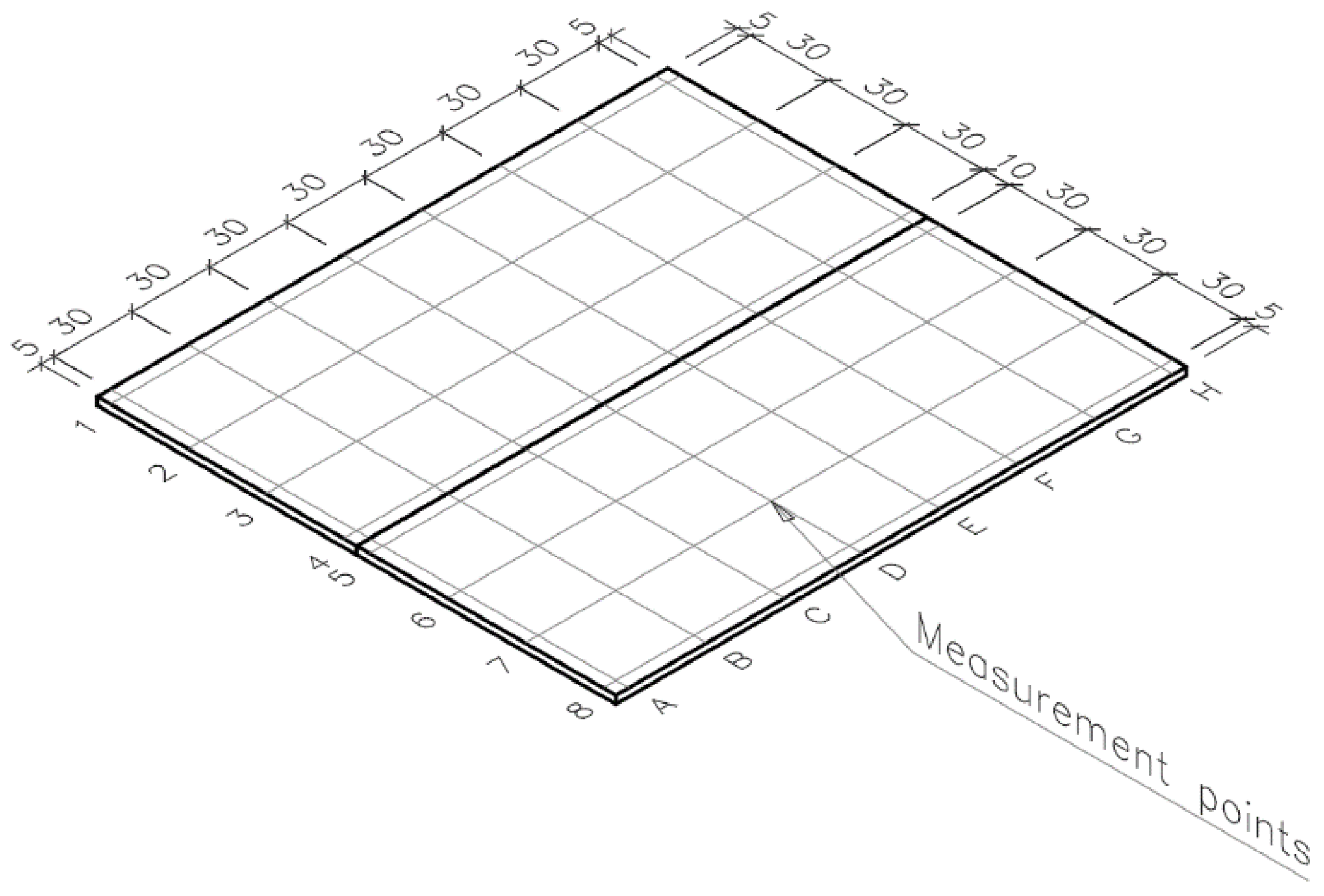
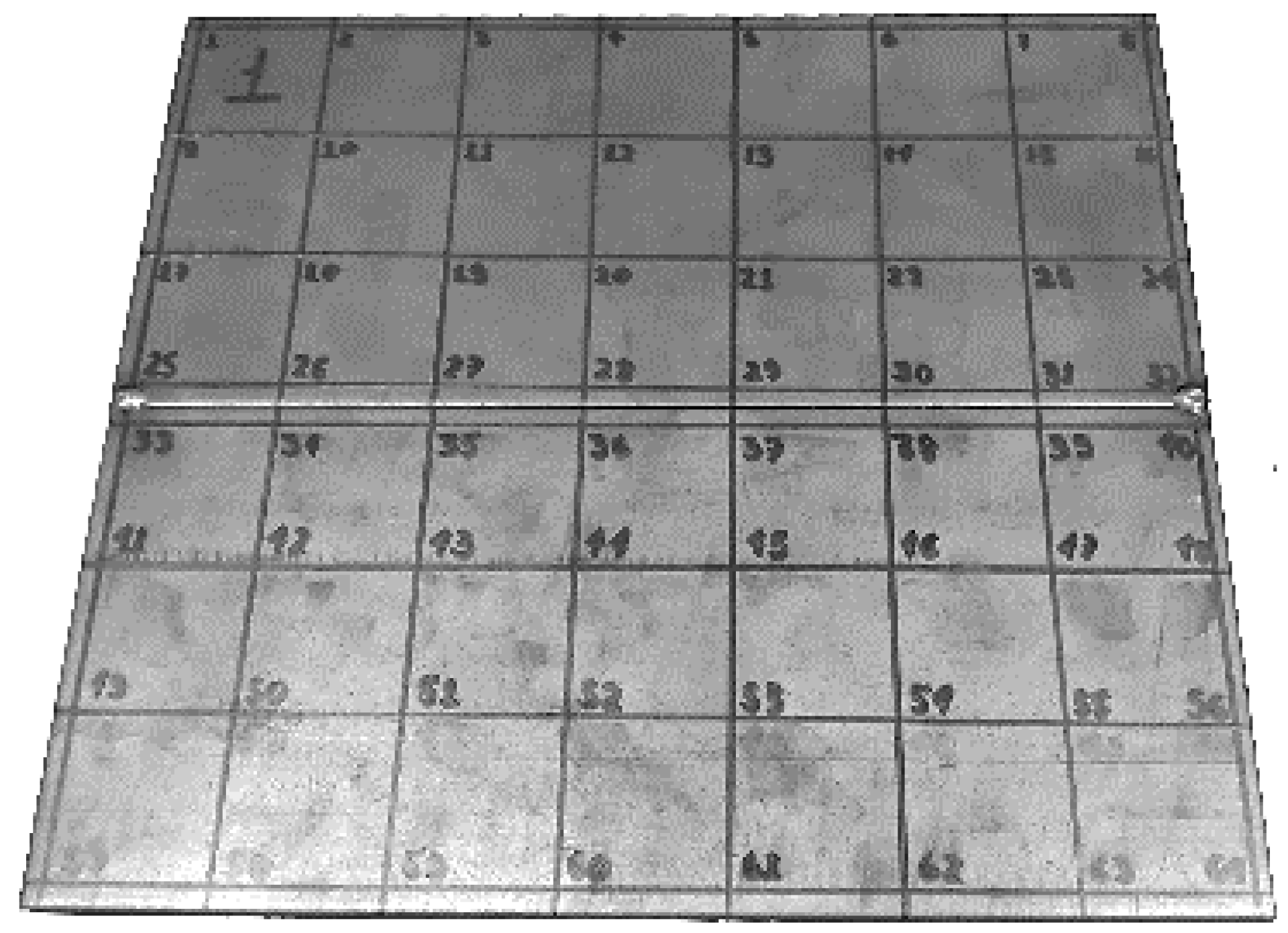

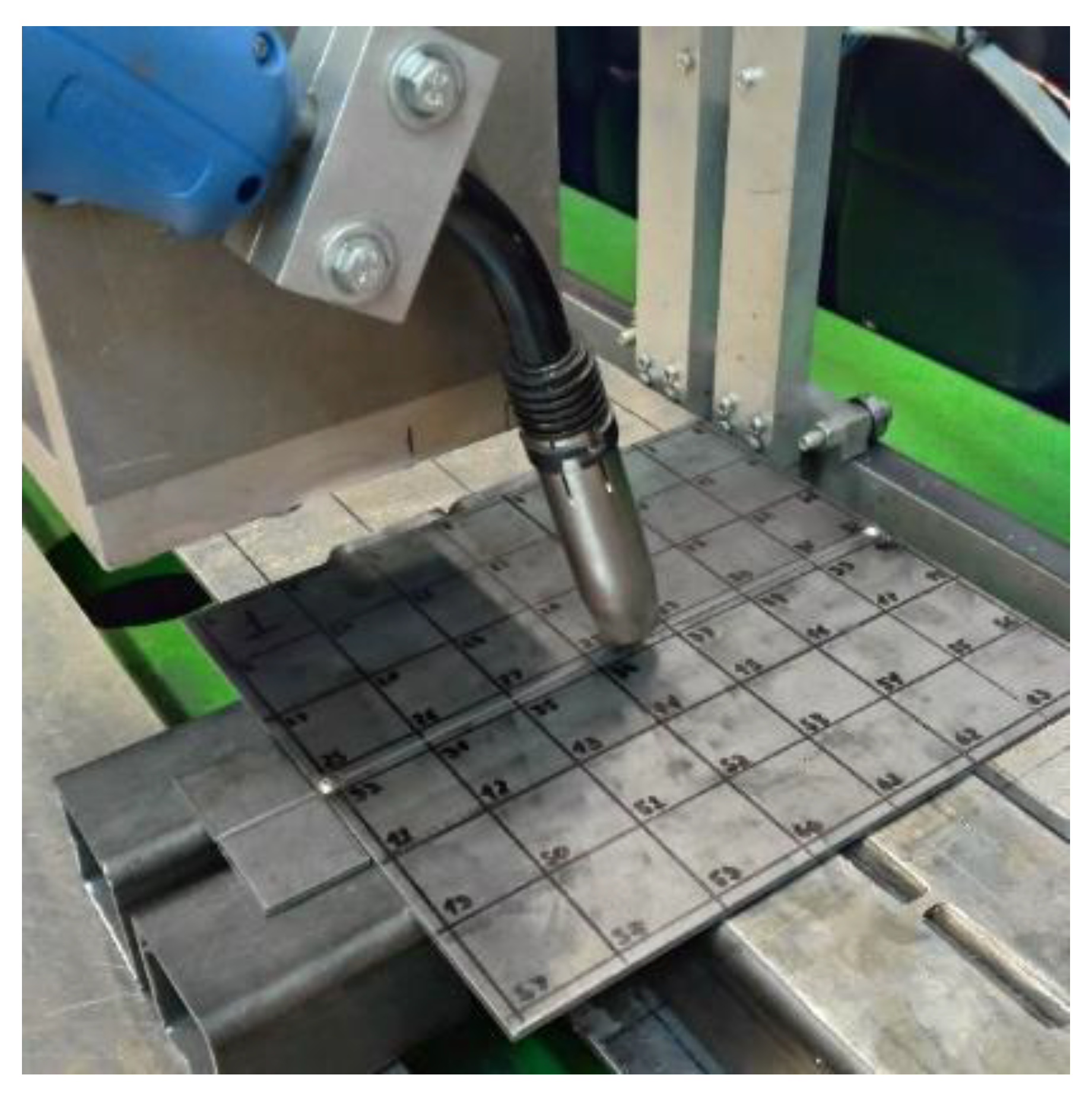
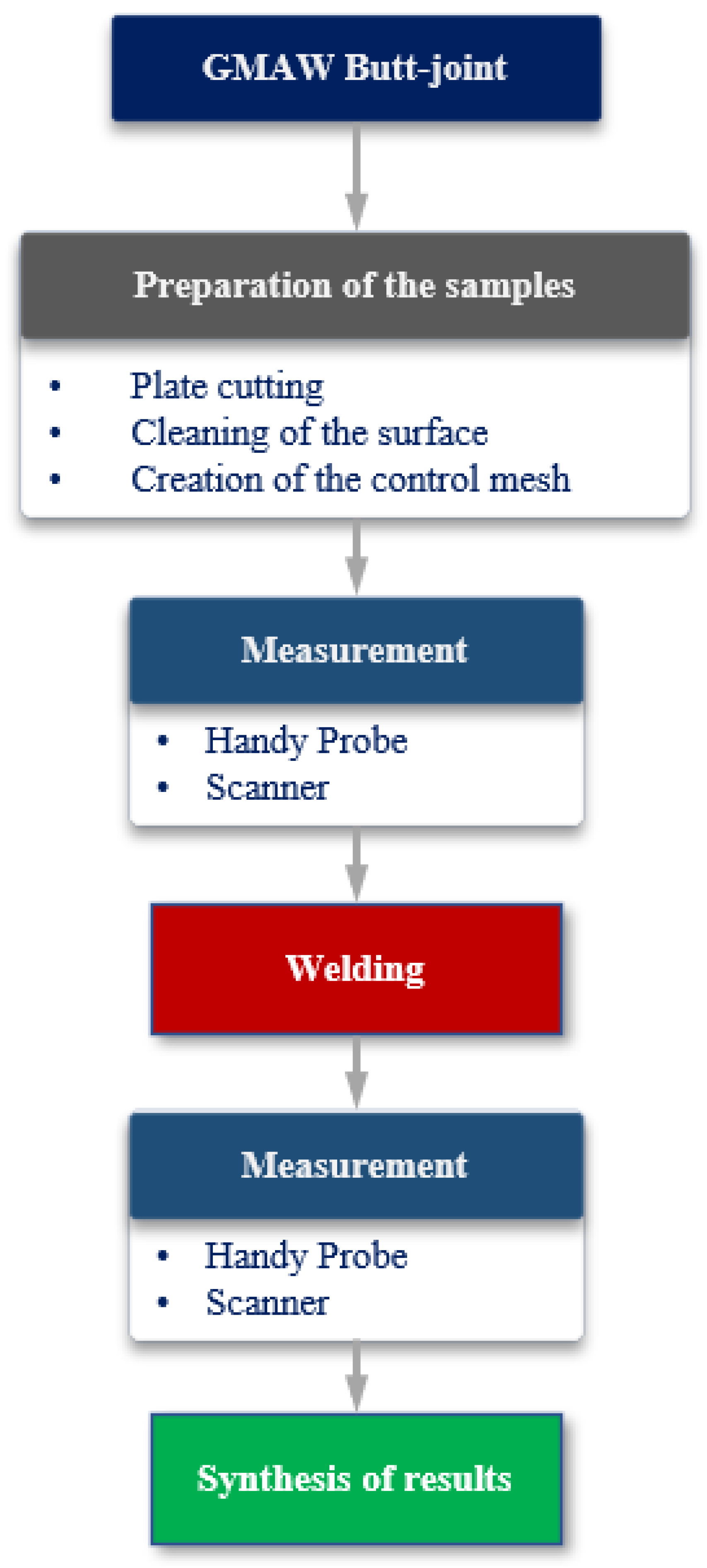
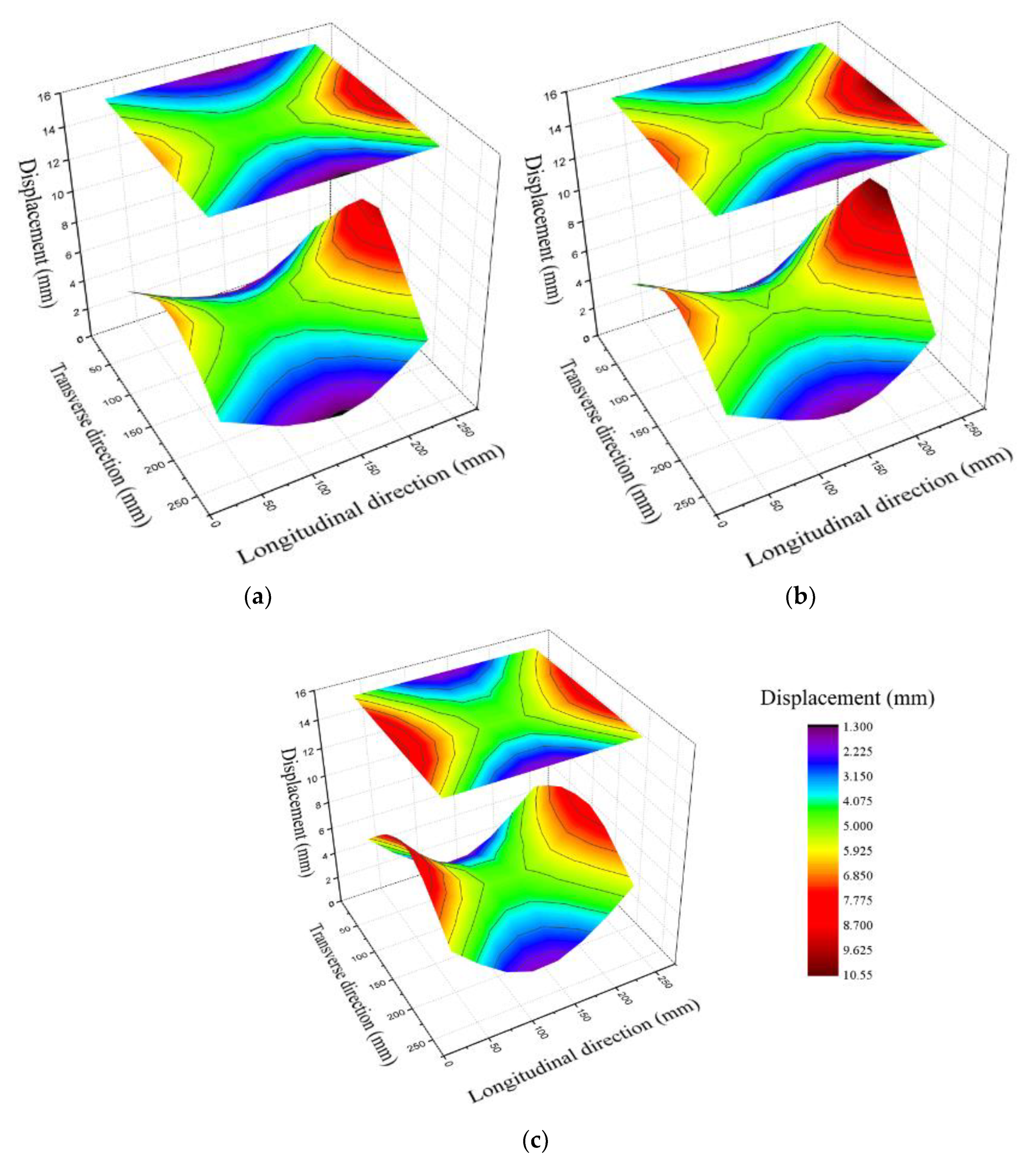
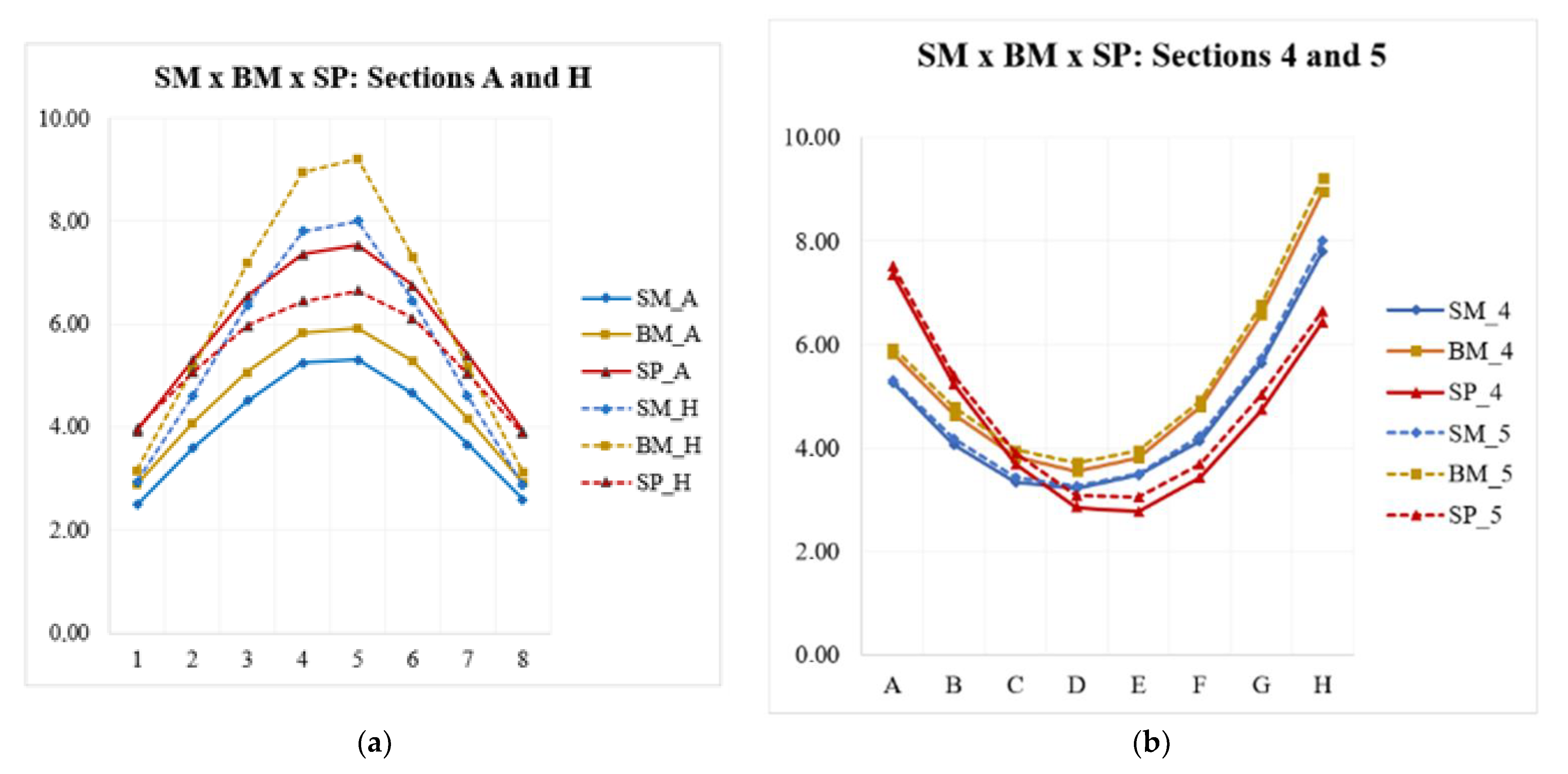
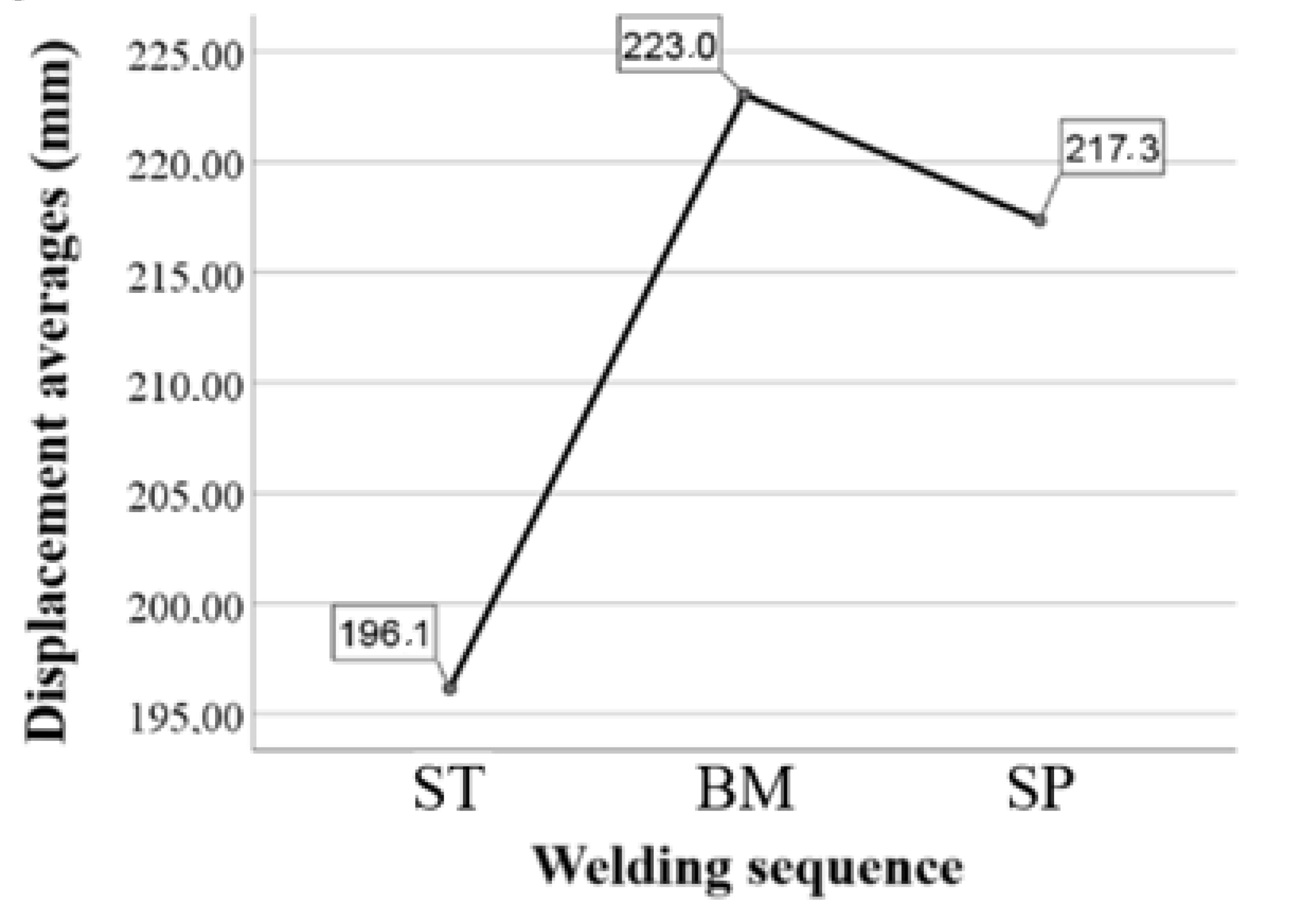
| C | Mn Max | P Max | S Max |
|---|---|---|---|
| 0.17–0.22 | 1.40 | 0.035 | 0.035 |
| Chemical Element | Minimum (%) | Maximum (%) |
|---|---|---|
| Carbon | 0.06 | 0.14 |
| Silica | 0.80 | 1.00 |
| Manganese | 1.40 | 1.60 |
| Phosphorus | 0.025 | |
| Sulphur | 0.025 |
| EUROTROD EN ISO | Mechanical Properties |
|---|---|
| M/SG 2 14341-A: G3 Si 1 | Re 420 N/mm2 Rm 520 N/mm2 A5 > 30% KV > 72 J (−30 °C) |
| Ø (mm) | Electric Current (A) | W | η | H | Electrical Supply | U |
|---|---|---|---|---|---|---|
| 0.8 | 80 | 14 | 95 | 0.8–3.0 | 3.2–13 | 18–24 |
| Welding Parameters | Used Values |
|---|---|
| Voltage | 22.4 V |
| Travel angle | 15° |
| Shielding gas flow | 14 L/min |
| Welding speed | 0.30 m/min |
| Feeding speed | 4.5 m/min |
| Electrode extension (Stick-out) | 19 mm |
| Comparison | F-Value | p-Value |
|---|---|---|
| SM_1-SM_2 | 0.240 | 0.878 |
| SM_2-SM_3 | 0.207 | 0.207 |
| SM_3-SM_1 | 0.366 | 0.546 |
| BM_1-BM_2 | 0.157 | 0.693 |
| BM_2-BM_3 | 0.155 | 0.695 |
| BM_3-BM_1 | 0.000 | 0.999 |
| SP_1-SP_2 | 0.190 | 0.890 |
| SP_2-SP_3 | 0.010 | 0.980 |
| SP_3-SP_1 | 0.026 | 0.872 |
| Kruskal–Wallis | Median Test | |
|---|---|---|
| SM | 0.193 | 0.440 |
| BM | 0.778 | 0.779 |
| PM | 0.982 | 0.990 |
| Sequence | Σ Displacement (mm) |
|---|---|
| SM_1 | 275.99 |
| SM_2 | 280.32 |
| SM_3 | 251.98 |
| BM_1 | 316.20 |
| BM_2 | 296.22 |
| BM_3 | 311.57 |
| SP_1 | 327.63 |
| SP_2 | 324.18 |
| SP_3 | 325.90 |
| Sum of Squares | Mean Squares | F | p | |
|---|---|---|---|---|
| Between Groups | 1205.667 | 602.834 | 10.337 | 0.011 |
| Within Groups | 349.892 | 58.315 | ||
| Total | 1555.559 |
| (I) Sequence | (J) Sequence | Average Difference (I-J) | P | Inferior Limit | Superior Limit |
|---|---|---|---|---|---|
| SM | BM | −26.901 * | 0.012 | −43.032 | −7.770 |
| SP | −211.202 * | 0.033 | −40.333 | −2.071 | |
| BM | SM | 26.901 * | 0.012 | 7.770 | 46.032 |
| SP | 5.699 | 0.652 | −13.432 | 24.830 | |
| SP | SM | 21.202 * | 0.033 | 2.071 | 40.333 |
| BM | −5.699 | 0.652 | −24.830 | 13.432 |
Publisher’s Note: MDPI stays neutral with regard to jurisdictional claims in published maps and institutional affiliations. |
© 2022 by the authors. Licensee MDPI, Basel, Switzerland. This article is an open access article distributed under the terms and conditions of the Creative Commons Attribution (CC BY) license (https://creativecommons.org/licenses/by/4.0/).
Share and Cite
Afonso, I.S.; Martín, M.R.; Ribeiro, J.E. Effect of Welding Sequence in Angular Distortion on Butt Joint GMAW Process. Appl. Sci. 2022, 12, 10402. https://doi.org/10.3390/app122010402
Afonso IS, Martín MR, Ribeiro JE. Effect of Welding Sequence in Angular Distortion on Butt Joint GMAW Process. Applied Sciences. 2022; 12(20):10402. https://doi.org/10.3390/app122010402
Chicago/Turabian StyleAfonso, Inês S., Manuel Rodríguez Martín, and João E. Ribeiro. 2022. "Effect of Welding Sequence in Angular Distortion on Butt Joint GMAW Process" Applied Sciences 12, no. 20: 10402. https://doi.org/10.3390/app122010402
APA StyleAfonso, I. S., Martín, M. R., & Ribeiro, J. E. (2022). Effect of Welding Sequence in Angular Distortion on Butt Joint GMAW Process. Applied Sciences, 12(20), 10402. https://doi.org/10.3390/app122010402







